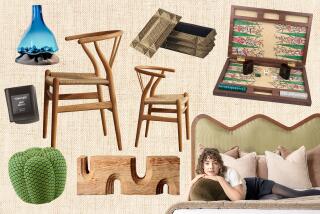Chameleon-like charisma
IN the glory days of Southern California tile -- think Batchelder, Malibu, Catalina -- few devotees of the craft would have imagined a time when earthy terra cotta, pristine porcelain and sublime ceramics would be upstaged by something as common as concrete.
Of course, that was before concrete countertops were so sleek and chic, before polished concrete floors were de rigueur for modern architecture, and certainly before handmade âcement tileâ joined the ranks of fashionable flooring.
Architects, interior designers and do-it-yourself remodelers these days are paying up to $35 a square foot for a style of tile that, ironically, is a low-cost staple in some Latin American countries -- what linoleum used to be in the U.S.
Why? For starters, despite the increased demand, decorative cement tile (sometimes called concrete tile) can still be less expensive than other types of art tile. But more than that, the cement pieces can have a rustic charm -- a timeworn beauty complemented by a chameleon-like versatility. They bear bold patterns and rich, dynamic colors that can look modern or historical, traditional or exotic.
âTheyâre new and different looking,â says Santa Monica-based textiles designer Kathryn M. Ireland, who installed Denis Colomb-designed tile made of cement and powdered marble in the kitchen of her home in France. âI like the matte finish to it, and I love the color.â
L.A. designer Peter Dunham says slightly irregular edges, hairline cracks and tiny variations in color are what make the tiles distinctive.
âThey look almost instantly vintage,â Dunham says.
The tile is an increasingly popular choice, whether for a newly built loft, an old Spanish Colonial house or a Moroccan-influenced manse, says Bonnie Cullinan, vice president of marketing for Classic Tile & Mosaic.
âIt has gotten much more popular in just the last six months,â Cullinan says, citing a growing number of homeowners who are using cement tiles in Moorish motifs. âMoroccan is really hot.â
No need to tell Scott Weiss, an L.A.-based residential designer and builder who recently installed cement tiles in a 4,000-square-foot Moroccan-influenced remodel in the hills of West Hollywood.
âAuthentic Moroccan tile is extremely expensive and is difficult to get, and the supply is not terribly reliable,â said Weiss, who used a bright blue-and-white geometric pattern for the entryway floor as well as a floral design in dusty reds and desert earth tones on the facades of two fireplaces to complement the houseâs distinctive archways. Using any other type of tile, he says, would have been like âhaving a birthday cake without the icing.â
The history of cement tile hasnât always been so sweet. In the first half of the 20th century, when dozens of tile manufacturers thrived in Southern California, only two companies -- Valencia Spanish Tile in Culver City and Barcelona Spanish Tile in Glendale -- produced decorative pieces in colored cement, according to Steven Soukup, a commercial architect and tile collector who has curated tile shows at the California Heritage Museum in Santa Monica and served as a design editor for the two-part book âCalifornia Tile: The Golden Era, 1910-1940.â He says Valencia and Barcelona are believed to have folded by 1950, before the style ever really gained a following here.
âCement tile has really taken a backseat to everything else until this point,â Soukup says. Now that the more intricate and effusively artful designs of Ernest Batchelder, Malibu Potteries and other top-flight manufacturers have received so much adoration, he says, some tile devotees are starting to explore the merits of lesser-known styles and materials, including cement.
Say âcement tile,â and most people envision plain pavers or pedestrian single-color squares. But encaustic cement tile -- a term used to indicate the use of multiple colors in a single piece -- can result in surprisingly intricate designs. Today these tiles are imported from Latin America and Morocco, where labor is less expensive and workers are already familiar with a little-changed, decades-old manufacturing process.
At a production site in Granada, Nicaragua, Marcos Cajinaâs company employs molds from the 1920s to create classic encaustic designs, some of which were installed in the lobby of the Roosevelt Hotel in Hollywood.
Granada Tile (www.granadatiles.com) uses metal molds like giant cookie cutters, into which colored cements are poured into sections to a depth of one-eighth inch, forming the tileâs top layer. While the cement is still fluid, the mold is pulled out so the different colors can collide, forming the design. Workers sprinkle half an inch of a dry cement mixture on top to add bulk and strengthen the pieces, then apply 4,000 pounds of hydraulic pressure to draw moisture from the colored cement through the dry backing.
The result is a solid, durable piece that becomes more polished as it wears. Thanks to its depth of pigment, the tile can sustain surface chips and still retain its color.
Those practicalities are important, but for Tisa Adamson, co-owner of the family-run Mission Tile West in South Pasadena and Santa Monica, the appeal is largely nostalgia. She fondly remembers her grandparentsâ 11-bedroom house in Nogales, Mexico, and its abundant cement tile on the floor, on the bathroom walls and as wainscoting in the hallway.
âIâve always had a passion for it,â says Adamson, whose South Pasadena store recently opened a kitchen and bathroom extension that includes three types of cement tile installed on the showroom floor. âIt becomes part of your self-conscious.â
She says clients who live in inland areas such as Pasadena like the tiles because in the heat of summer, they feel cool underfoot. Others use the tile like a rug, a decorative accent surrounded by less-expensive terra cotta.
âA lot of times people will see a tile and not know itâs concrete,â says Budd Newcomb, spokesman for the Concrete Tile Manufacturers Assn. Indeed, preservationists who remember the vibrant lobby floor inside the Julia Morgan-designed Herald Examiner building in downtown Los Angeles may not have realized that the tile was cement, not ceramic. Ditto the mod tile recently installed at the Spider nightclub in Hollywood.
The San Diego showroom of Classic Tile & Mosaic recently installed Granadaâs $18 tiles in a 5-foot-wide strip from the front door to the rear of the store and up a wall. Manager Victoria Horn says the response was immediate.
âEven though itâs concrete, it feels very warm. Itâs quite inviting,â she says. Some people choose it so their renovations are historically correct, she says. And others? âSome people just think itâs cool.â
Craig Nakano can be reached at [email protected].
More to Read
Sign up for The Wild
Weâll help you find the best places to hike, bike and run, as well as the perfect silent spots for meditation and yoga.
You may occasionally receive promotional content from the Los Angeles Times.







